It is not an easy task to briefly talk about Brazilian culture.
With the wide range of cultures in Brazil, it would be necessary to write a thick book to cover all of our customs, and even then, you would only scratch the surface of this country with continental proportions.
Still, I took the daring job of summarizing the Brazilian traditions, history, language, religions, celebrations, cuisine, art, music, folklore, sports, family values, gender, social class, ethnicity, and social customs.
Phew. That’s a lot, I know!
Brazilian culture
With a lot of personal experience and hours of researching, I finally wrote this is a comprehensive and practical article about the Brazilian lifestyle as well as the most diverse facts about Brazilian culture. Still, I promise you it isn’t boring! Far from that, actually.
I tried my best to show the culture of Brazil in an interesting way, and I hope you will enjoy the read. Honestly, not even the Brazil Wikipedia page can be so practical when talking about history and traditions.
Let’s get to it!

Brazilian history
It’s impossible to talk about Brazilian culture without explaining the country’s background. So I’ll start this article by briefly covering Brazilian history and the events that made Brazil the country it is today.
However, I couldn’t possibly discuss all the crucial events, revolts, and happenings in this summary. For such a young country, Brazil has a lot of history!
That’s why this is a summary of a summary. If you want to learn more about it, I’ll soon publish a more comprehensive article about Brazilian history. Keep an eye out for that!
The beginning
According to most history books, the history of Brazil begins in 1500 when the Portuguese first set foot in this vast territory.
Despite textbooks only documenting what happened after that, the Indigenous Brazilians already had a complex form of society that went far beyond wearing few clothes and living in bamboo structures.
In fact, the Indigenous Brazilian had a sophisticated system to use nature in their favor, far more complex than the Brazilian society’s system of deforestation of a large area and throwing cattle or soy in its place.

They thought of nature as a means of finding food in the long run. So they made sure to use the natural resources smartly so that they could use them again in the future.
As I said, the Indigenous Brazilian had a complex form of society and were divided into tribes. Each tribe had its own language, hence why hundreds of languages were being spoken in this territory at that time (and still are).
For instance, one language of those languages, the Tupi, was almost the only one spoken on our vast coast from Maranhão to São Paulo, which shows how that tribe conquered the coast, imposing their language on the local inhabitants with such success. Almost like the Latin in southern Europe during the Roman Empire.
Portuguese colony
Fast forward to the 16th century, Pedro Álvares Cabral arrived under the sponsorship of the Kingdom of Portugal at the city we today call Salvador in Bahia State. The date was April 22, 1500.
For four centuries, Brazil was a Portuguese colony. During that time– and a few more years after independence– the Indigenous Brazilians were subjugated to the worst treatment and forced to build the country and convert to Catholicism, the predominant religion in Portugal back then.

Because that land was covered in jungle, it was challenging to chase locals, so the crown sent para-military adventurers called bandeirantes to search more slaves and eventually for gold.
The constant need for slaves was due to the dramatic mortality rates of slaves, particularly in sugar fields and gold mines. The bad conditions and diseases brought to South America ensured that the population decreased at a rapid pace.
However, colonists were no longer able to replace the slaves using natives, at least not at the rate they wanted, so they enslaved millions of West-African people in Brazil.
Slavery in Brazil
Of all African slaves exported worldwide, about 46% went to Brazil, which is why the Africans became a substantial part of the Brazilian population.
In total, Brazil imported over 4 million African slaves during those centuries. They worked mostly in the plantation fields, building cities, and mining gold.

Slave rebellions were frequent, and the biggest of the revolts was led by Zumbi dos Palmares, leader of the slave resistance.
Most, if not all, of the fugitive slaves in his massive community were experts in capoeira, a martial arts form developed by African slaves to defend themselves from the colonialists.
Empire of Brazil
In 1808, the Portuguese court moved the government apparatus to its then-colony, Brazil, establishing themselves in Rio de Janeiro, fleeing from Napoleon’s Portugal invasion.
From there, the Portuguese king ruled his colossal empire for 15 years, and there he would have remained for the rest of his life if it were not for the turmoil aroused in Portugal due, among other reasons, to his extended stay in Brazil after the end of Napoleon’s reign.
So in 1822, the Brazilian Prince Dom Pedro declared Brazil independent of Portugal. The date which marked the Empire of Brazil was September 7th, 1822.
During that time, Brazil was already producing half of the world’s coffee, and since these plantations were in São Paulo State, it made the state financially and politically crucial for the country. The rubber boom in the Amazon also helped to reshape the economy radically.

Around 1850, Brazil stopped importing slaves after 40 years of British pressure. However, that created a problem for landowners since slaves didn’t live long due to their precarious and exhaustive conditions.
On top of that, the African slaves were their only “workers” at that point.
In the meantime, Italian and Japanese immigration increased considerably, especially in the country’s southeastern region.
These people immigrated to Brazil led by the socioeconomic changes in Italy and the high demographic rate in Japan, becoming the largest Italian and Japanese communities outside their homeland.
Beyond that, they came to fill the lack-of-slaves gap working mostly in the fields, especially the coffee plantations.
However, Princess Isabel proclaimed the abolition of slavery in May 1888 due to international pressure. While that was a long-overdue decision, people of color in Brazil didn’t necessarily have a better life after that.
Post-slavery in Brazil
The ex-slaves, generally people of color, had no housing, no job, no one wanted to hire them, especially paying a decent rate. On top of that, racism was in every corner of Brazil.
For these reasons, those people were pushed away from the city and forced to live in the far suburbs.

It is in this context that the favelas in Rio de Janeiro came into being. The ex-slaves, together with homeless soldiers returning from the Canudos War, built wooden houses on the hills surrounding the city.
Interestingly, the wood used to build the houses was similar to a tree those soldiers came across during the war in Bahia. That tree was called favela, which is why the hill became known as Morro da Favela, Portuguese for Favela Hill.
Republic of Brazil
In 1889, a Republican military coup deposed the emperor, who was in a party in the castle of Ilha Fiscal in Rio de Janeiro.
The stars you see on Brazil’s flag today represent the starry night on that historic day. The date was November 15th, 1889.
Eventually, the economic focus shifted away from Rio because of the increasing importance of São Paulo and Minas Gerais (due to coffee and milk production).

From that moment until the mid-20th century, many revolts took place in Brazil, especially for political reasons, and between 1964-1985, the country was under a military dictatorship.
After the re-democratization of Brazil in 1985, the country started working toward a better economic situation, and in an attempt to stabilize the domestic currency, President Itamar Franco set the Real Plan in motion.
Lula, from president to prisoner
The Real Plan introduced a new currency called real (Portuguese for royal) in place of the old cruzeiro, together with other economic policies.
Those policies helped the country, but the highly unequal distribution of wealth and income remained pretty much the same. In fact, that still is one of the biggest problems in Brazil to this day.
Just so you can have an idea: in the 1990s, more than one out of four Brazilians survived on less than one dollar a day. That was scary.
These socio-economic contradictions helped elect Luiz Inácio Lula da Silva in 2002. Lula was a candidate of the Workers’ Party (Partido dos Trabalhadores – PT).
In 2005, Lula’s government suffered a serious blow with several accusations of corruption and misuse of authority against his cabinet, forcing some of its members to resign.

Most political analysts at the time were confident that Lula’s political career was doomed. Still, he managed to hold onto power, partly by highlighting his term’s achievements, which reduced poverty, unemployment, and dependence on external resources, such as oil.
It is in this context that Lula was re-elected president in the general elections of October 2006.
Having served two terms as president, Lula was forbidden by the Brazilian Constitution from rerunning a campaign. That’s why the PT candidate for 2010 was Dilma Rousseff.
Under public support of Lula, who was very popular among a large part of the population, particularly in the northeast, Rousseff won and assumed office on January 1, 2011, as the country’s first female president.
However, Lula was arrested on corruption charges in 2018.
World Cup and impeachment in Brazil
Let’s take a step back to understand what led to Lula’s arrest.
Nationwide protests broke out in 2013 and 2014 primarily over public transport fares and excessive government spending on the 2014 FIFA World Cup.
Even though Rousseff faced a challenge for her presidential candidacy in 2014, she managed to secure her re-election with just over 51% of votes.

Two years later, the country was still in a recession that had begun after the 2014 FIFA World Cup.
That, together with a corruption scandal called Car Wash, resulted in President Rousseff’s impeachment for mismanagement and disregard of the national budget in 2016.
Bolsonaro, from president to joke
Despite Bolsonaro’s misogynist and racist remarks as well as his admiration for the 21-year military dictatorship in the country, the far-right congressman and former army captain Jair Bolsonaro was elected President of Brazil in 2018.
Rainforest fact: During Bolsonaro’s first year as president, the Amazon Rainforest’s deforestation reached its highest level in 11 years despite the rainforest’s crucial role in mitigating climate change.
Beyond that, Bolsonaro’s policies were a strong incentive to increase industry exploration in the rainforest.

Just so you can have an idea of how bad that is, the deforestation method used for clearing forest areas, the so-called slash-and-burn, led to an overwhelming increase in Amazon rainforest wildfires in 2019 compared to previous years.
In 2020, Bolsonaro and his wife have also been involved in corruption scandals, but he remained in his position.
Brazilian language
Portuguese is the only official language of Brazil, but it’s slightly different from the one spoken in Portugal. Still, we can easily understand each other in writing and speaking.
The dialect we speak in Brazil is called Brazilian Portuguese.
Aside from this language, there are numerous minority languages spoken throughout the country, from indigenous languages to Polish, Italian, Japanese, German, and Ukrainian dialects.

As of 2019, the population of Brazil speaks (or signs) approximately 228 languages, of which 217 are indigenous, and 11 came with immigrants. However, fewer than 40,000 people in Brazil speak any of the indigenous languages.
Portuguese in the words of Olavo Bilac:
(…) unknown and obscure,
Tuba of high blare, delicate lyre,
That holds the frill and the hiss of the tempest
And the singing of the saudade and of the tenderness!
Religions in Brazil
Brazil is a notorious religious country because it is a former Portuguese colony and has many immigrants from firmly believing countries.
According to the Brazilian Institute of Statistics and Geography (IBGE), about 64% of the population is Catholic, 22% is Protestant, 2% is Spiritist, about 3% adhere to other religions, and 8% have no faith.
Unsurprisingly, Catholicism has been Brazil’s main religion since the beginning of the 16th century. For instance, Indigenous Brazilians were forced to convert to catholicism by Jesuit missionaries.

For obvious reasons, there was no freedom of religion during the colonial times, hence why the native Brazilians practiced their own belief in hiding.
Today, these are the most prominent Christian religions in Brazil:
- Catholicism
- Protestantism
- Orthodoxy
- Jehovah’s Witnesses
And these are the most significant non-Christian religions in Brazil:
- Candomblé – Afro-Brazilian religion developed in the early 19th century.
- Umbandism – Afro-Brazilian religion that blends African traditions with Roman Catholicism, Spiritism, and Indigenous American beliefs.
- Spiritism – Founded in the 19th century by Allan Kardec.
- Buddhism – The Japanese were the main community that adhered to Buddhism.
- Judaism
- Islam – The Arab was the main community that adhered to Islam.
Celebrations in Brazil
Being a cultural melting pot like Brazil, it is expected that we have many different celebrations and traditions throughout the five regions.
Here we have the most incredible mix of people from different parts of the world, different beliefs, and cultures.

Among our long list of national holidays, the biggest celebrations in Brazil are:
- Carnival – Rio de Janeiro, São Paulo, Salvador, Ouro Preto, Florianópolis, Recife, and Olinda have the biggest carnival celebrations in the country.
- Parintins Folklore Festival – Also called Bumba Meu Boi, it is one of the biggest festivals in Brazil, only behind the carnival in Rio and Salvador.
- Gay Pride – The São Paulo Gay Pride Parade in Brazil is South America’s largest event and is listed by Guinness World Records as the world’s largest Pride parade. It welcomed 2.5 million people in 2006, 4 million attendees in 2009 with similar numbers to at least 2016, and 5 million attending in 2017.
- June Party – It celebrates the nativity of St. John the Baptist (June 24) and is filled with bonfires, music, dance, food, and traditional clothing.
- Oktoberfest – The most significant German festival in the Americas takes place in Blumenau, Santa Catarina State.
Brazilian cuisine
Brazilian food, just like our religions, celebrations, and music, has mostly been influenced by southern European, west and southwestern African, Amerindian, and northeastern Asian cuisines.
Most Brazilian dishes are hearty, and while most savory recipes call for meat, lots of oil, cassava, sofrito, or seasoning. On the other hand, Brazilian desserts are often very sweet, and many have a fruity base.
Our dishes vary significantly by region, reflecting the country’s mix of native and immigrant populations and its continental size as well. These aspects created a national cuisine marked by the preservation of regional differences.

Besides, Brazilians are passionate about food. So if you’re having a meal at a Brazilian house, beware: it is more than a meal; it is an event.
Fun fact about Brazilian culture: Avocados are considered a fruit that should be eaten with sugar in Brazil. We often serve it in a delicious smoothie.
Some popular dishes in Brazil are:
- Rice and beans – it is the base for many meals.
- Feijoada – black beans stew with meat, which is considered the national dish of Brazil.
- Barbecue (churrasco) – southern Brazilian influence.
- Moqueca – consisting of slow-cooked fish in palm oil and coconut milk, tomatoes, bell peppers, onions, and garlic, topped with cilantro.
- Acarajá with vatapá – African influence.
- Feijão tropeiro – a dish from colonial times when the Bandeirantes traveled the country looking for people to enslave and gold.
Popular appetizers in Brazil:
You can check out a comprehensive list of Brazilian appetizers here.
- Brazilian cheese bread
- Coxinha
- Pastél
- Kibbeh – Arabic influence.
Popular desserts in Brazil:
You can check out a comprehensive list of Brazilian desserts here.
- Brigadeiro
- Carrot cake with chocolate
- Brazilian birthday cake
- Beijinho
- Quindim – Portuguese influence.
- Dulce de leche
- Brazilian flan
Popular drinks and cocktails in Brazil:
You can find a comprehensive list of Brazilian drinks and cocktails here.
- Caipirinha – national cocktail of Brazil made with cachaça, a Brazilian liquor.
- Chimarrão – yerba mate tea.
- Passion fruit juice – This juice is quite popular in the country.
- Sugar cane juice
- Fruit juices – Because the climate is ideal for growing most fruits.
- Coffee – Brazilian coffee is the most consumed worldwide and makes an excellent souvenir too.
- Brazilian beer
- Guaraná – Brazilian fruit caffeinated soft drink made from guaraná seeds.
- Batida – Fruit punch.
Brazilian literature
While our music is far more popular worldwide, Brazilian literature is one of our most important art forms.
Like most aspects of our culture, our literature initially followed Portuguese trends in its early years. However, it gradually shifted to a different and authentic writing style in the 19th and 20th centuries, searching for truly Brazilian themes and Brazilian forms.

The highest literature award of the Portuguese-speaking countries is called the Camões Prize, and Brazil holds 13 awards. However, the Prêmio Jabuti (Tortoise Prize) is the most significant literary award in Brazil and was created in 1958 by Edgard Cavalheiro.
Also, the most important literature events are the Festa Literária Internacional de Paraty (Flip) and São Paulo Biennial.
Here are some of the leading Brazilian writers with respective significant books and literary schools:
Romanticism
- Gonçalves de Magalhães: Suspiros Poéticos e Saudades
- Castro Alves: Navio Negreiro
- Gonçalves Dias: I-Juca-Pirama
- José de Alencar: The Guarani, Iracema
Brazilian Realism
- Aluísio Azevedo: O Cortiço (The Slum)
- Machado de Assis: Memórias Póstumas de Brás Cubas (Brás Cubas’ Posthumous Memoirs), Dom Casmurro (one of the best Brazilian books), The Alienist, Quincas Borba
Pre-Modernism
- Euclides da Cunha: Os Sertões (Rebellion in the Backlands)
Modernism
- Mário de Andrade: Macunaíma
- Oswald de Andrade: Anthropophagist Manifesto
- Jorge Amado: Dona Flor and Her Two Husbands, Gabriela Cravo and Cinnamon, Captains of Sand
Postmodernism
- João Guimarães Rosa: Grande Sertão: Veredas
- Clarice Lispector: Água Viva and The Hour of the Star (I love this one!)
Contemporary Brazilian literature
- Manoel de Barros (Tortoise Prize): The book of ignorance, Memórias inventadas
- Rubem Fonseca: August, High Art
- Adriana Lisboa: Symphony in White, Crow Blue
- Ferreira Gullar (Nominated for the Nobel Prize): Dirty Poem
- Paulo Coelho: The Alchemist, Eleven Minutes
Brazilian art
Painting and sculpture
Brazilian painting emerged in the late 16th century, and back then, it was greatly influenced by the Baroque style, which was predominant in Portugal.
That style was strongly used in Brazil until the beginning of the 19th century when the Royal School of Sciences, Arts, and Crafts was founded in Rio de Janeiro to dictate art standards.
Namely, a mixed trend of Romanticism, Neoclassicism, and Realism, portraying Brazil’s battles, history, landscapes, and people.

Late in the 20th century, new styles emerged, such as neorealism, pop art, and neo-expressionism, contributing to the vast diversity in Brazilian art.
Some of the most famous Brazilian painters are:
- Anita Malfatti – Modernism
- Lasar Segall – Impressionism, expressionism, and modernism
- Tarsila do Amaral – Modernism
- Cândido Portinari – Abstractionism
Some of the most famous Brazilian sculptors:
- Aleijadinho – Colonial Baroque
- Francisco Manuel Chaves Pinheiro – Neoclassicism, Romanticism
- Francisco Brennand – own style
Indigenous paintings can be found in the Serra da Capivara in Piauí National Park, a UNESCO World Heritage Site and testimony to one of South America’s oldest human communities.
Architecture
From the 16th to the early 20th century, Brazilian architecture was basically nonexistent. European styles, such as colonial, baroque, neoclassical, and gothic revival, were adopted throughout the country.
However, the need for functional structures—rather than beautiful ones—became more critical with the end of World War II.

That’s when Oscar Niemeyer introduced a modernist style that would become Brazil’s first architectural style and one of the world’s most recognized.
Niemeyer designed:
- Copan Building
- Alvorada Palace (Presidential Palace)
- National Congress of Brazil
- Planalto Palace (Official workplace of the president)
- Pampulha Architectural Complex
- Ibirapuera Park (together with Burle Marx)
- Headquarters of the United Nations in New York
- Niterói Contemporary Art Museum
- Latin America Memorial
Cinema
Brazilian cinema was introduced early in the 20th century but took some time to consolidate itself as a popular entertainment form.
Back then, there was a significant lack of people of color in the cast due to the country’s European colonization.
Slowly, women, working classes, and other ethnicities were given their deserved space on the screens.
Still, in the 20th and beginning-21st, many memorable movies were produced in Brazil, such as Dona Flor and Her Two Husbands, Central Station, City of God, The Man Who Copied, Carandiru, Madame Satã, Olga, Two Sons of Francisco, and Elite Squad.
You can find several of the Brazilian movies on Netflix, as well as some Brazilian series.
Brazilian music
As in many aspects of Brazilian culture, our music also shows diverse regional musical styles influenced by African, European, and Amerindian music.
While we have countless music genres, I will describe the most popular ones below, together with the most prominent Brazilian singers in each genre. Almost all of these genres are accompanied by dancing.
One doesn’t necessarily have to dance, but I guess that’s also a treat of our culture—many Brazilians enjoy dancing.

Samba
The most famous form of Brazilian music, samba, is unique to Brazil, with its roots in West African cultural expressions and Brazilian folk traditions.
It originated in the Afro-Brazilian communities of Rio de Janeiro in the early 20th century. It became a voice for those who had been silenced by their socio-economic status. Today, samba is at the core of Brazilian national identity.
Samba singers:
- Elza Soares
- Jorge Ben Jor
- Martinho da Vila
- Chico Buarque de Holanda
- Zeca Pagodinho
- Jorge Aragão
- Arlindo Cruz
- Diogo Nogueira
Bossa nova
Bossa nova is a new style of samba developed between the 50s and 60s.
Bossa nova singers:
- Toquinho
- Chico Buarque de Holanda
- Carlos Lyra
MPB
MPB stands for Música Popular Brasileira (Popular Brazilian Music) and is a style post-bossa nova that combines samba, other Brazilian regional music, and jazz.
MPB singers:
- Martinho da Vila
- Djavan
- Caetano Veloso
- Chico Buarque de Holanda
- Gilberto Gil
- Maria Bethânia
- Roberto Carlos

Sertanejo
Sertanejo has its origins in the countryside of Brazil. This genre originated in the 20s. A few subgenres of sertanejo are particularly popular among the youth, such as sertanejo universitário (college sertanejo).
Sertanejo singers:
- Paula Fernandes
- Gusttavo Lima
- Marília Mendonça
- Luan Santana
- Michel Teló
- Daniel
- Chitãozinho & Xororó
- Zezé Di Camargo
Forró
It is an upbeat music style that originated in the northeast of Brazil and is played by an accordion, triangle, and a zabumba.
Fun facts: The word forró is a derivative of the English expression “for all” used to classify parties that were thrown for the general public.
Forró singers:
- Wesley Safadão
- Elba Ramalho
- Zé Ramalho
- Alceu Valença
Pagode
Pagode is a subgenre of samba that originated in Rio de Janeiro, and it is characterized by its simple acoustic approach and light percussion.
Pagode singers:
- Zeca Pagodinho
- Jorge Aragão
- Arlindo Cruz
- Thiaguinho

Funk Carioca
Funk is a type of dance music from Rio de Janeiro that originated in the 90s. This genre is a cultural expression of some Afro-Brazilian communities in the city, more precisely, the favelas.
Funk singers:
- Anitta
- Kevinho
- Ludmilla
- MC Fioti
Axé
Originating in the 80s, this genre from Bahia State is a fusion of Afro-Caribbean and Brazilian genres.
Axé singers:
- Margareth Menezes
- Ivete Sangalo
- Daniela Mercury
- Claudia Leitte
- Netinho
- Durval Lélys
Brazilian folklore
Because Brazil is a melting pot of cultures, many Brazilian mythology elements are shared by other countries’ traditions, including our South American neighbors and Portugal.
Beyond that, Brazilian folklore has cultural features of the diverse origins of Brazil, including the indigenous people, Iberian traditions, African beliefs, and contemporary elements that are re-elaborations of old habits.

These are the prominent figures in Brazilian folklore:
- Boi-Bumbá – an ox that is lively celebrated in the Parintins Folklore Festival.
- Boto – an Amazon river dolphin (a Brazilian animal) that shapeshifts into a handsome man to seduce young women.
- Caipora – an entity of the Tupi-Guarani (Indigenous Brazilian) mythology who is a jungle spirit that lives in trees but comes out at night to haunt those who are astray.
- Curupira – a male jungle genie that protects the animals and the trees of the forests. It has red hair and backward feet to confuse hunters.
- Homem do saco (Sack man) – an elderly drifter who visits households searching for naughty young children to carry away with him in his sack. This story is commonly told to children as a way to make them behave.
- Iara – an entity of the Tupi-Guarani mythology who is a freshwater mermaid.
- Iemanjá – the Afro-Brazilian sea goddess worshiped in Umbanda and Candomblé, Afro-Brazilian religions.
- Lobisomem – the Brazilian version of the werewolf.
- Mula sem cabeça (Headless mule) – shape taken by the woman accursed for having a relationship with a priest.
- Saci Pererê – a mischievous single-legged elf-like creature of color, which is blamed as the culprit of anything that goes wrong at farms. This figure is most likely derived from a slave.
Sports in Brazil
The country of soccer is also the country of many other sports! In fact, Brazil is among the top teams in some other categories worldwide.
While not every Brazilian likes sports (obviously), a fair share of the population is heavily involved in different sports.

These are the most popular sports in Brazil by athletes and social involvement.
- Soccer
- Volleyball
- Table tennis
- Swimming
- Futsal
- Capoeira
- Skate
- Surf
- Judo
- Athleticism
- Tennis
- Handball
- Basketball
- Boxe/jiu-jitsu
- Formula 1, Stock Car, Formula Truck
Family values
Brazil is a society with strong traditional values, where people usually maintain strong ties with both the direct and extended family.
Because the family structure is so traditional, most households are patriarchal and are often represented by a hetero couple and their children.
However, this situation is slowly changing to a scenario where women are independent, and same-sex couples are normal as Brazil follows the world trend.

Fun fact about Brazilian culture: Most people carry toothpaste and toothbrushes in their purses/backpacks so they can brush their teeth after eating.
Gender
Although we host one of the world’s biggest Gay Prides, that doesn’t mean there isn’t prejudice or homophobia in the country. Unfortunately, the reality is far from that.
The LGBTQ community frequently deals with intimidation and threatening situations, especially in smaller cities—from workspace to school and the streets.
The good side of this story is that narrow-minded people in Brazil are (slowly) learning how to respect others as it becomes “socially acceptable” in the mainstream media.
In the last senate elections, a few transgender people were elected, showing the direction the country is taking. Better late than never, my professor used to say.

Social class
Unfortunately, Brazil inherited a highly traditional and stratified class structure from its colonial period with deep inequality.
In recent decades, the unfolding of a large middle class has contributed to increased social mobility and reduced income disparity. Still, the situation is far from ideal.
Because of Brazil’s past, namely slavery and racism (which is still in the present), race and class imbricate, producing a normatively white upper- and upper-middle-class and an afro-descendant working-class and poor.

Fun fact about Brazilian culture: The local sewage structure can’t handle toilet paper, which is why nobody ever throws it into the toilet. Every house, café, and hotel has a trash bin for used toilet paper.
Ethnicity
Brazil is the most diverse country in the world. Period. This statement is true in every single aspect of our culture and society—from animals to landscapes to ethnicities and more.
In fact, Brazilian society is composed mostly but not exclusively of Indigenous-, Portuguese-, West-African-, Italian-, Arab-, Japanese-, and German descendants. We have literally all skin colors and facial features beautifully mixed in our country.
However, although Brazil is clearly a multicultural society formed by diverse ethnic groups, up until recently, only fair- and light-skinned people would appear in magazine covers and TV commercials, have better jobs and opportunities, and all of those things you already imagine white privilege makes possible.
Mind you, Brazil is a multicultural society, but about half of our population is dark-skinned, meaning our biggest ethnic group is far underrepresented in the media.
For years, afro-textured hair was portrayed as “bad hair,” and a wide nose was not considered part of the Brazilian beauty standards because of its association with poor people. How ridiculous is that?!

However, the mainstream media is slowly and steadily portraying the real Brazilian people as they are, and many famous Brazilians are accepting their natural physical features, which serves as a positive influence on the people.
Nowadays, you see more and more women with natural hair—curly and afro-textured hair. That wasn’t the case a few years ago.
Fact about Brazilian culture: About 75% of the people who live in extreme poverty in Brazil are people of color.[1]
Stereotypes
It’s all pretty complex, and stereotypes are counterproductive. I often hear from internationals that Brazilians are all people of color. I’ve seen people ask a white Brazilian if she was indeed Brazilian because, you know, she was “too white for that.”
Wait, what?!
That’s wrong. As you have read above, we have multiple ethnic groups in Brazil. Literally, everyone can be Brazilian.

Also, one of the things people associate with Brazil is wild animals.
While we do have abundant wildlife, Brazil is a country with continental proportions, and although the Amazon covers a big part of our country, most populated cities and towns are far from the rainforest. In fact, most people live in cities just like the ones you’re used to.
These are a few of the Brazilian stereotypes some people abroad have, but let me tell you something: there is nothing exotic about us.
Naming
Brazilian names follow the Portuguese naming patterns, where someone’s name traces back to their ancestry or profession.
Most people usually have two last names in Brazil, the first being from the mother and the second from the father.
For example, Maria Machado Barreto married João Silva Santos. Their child is named Iara Barreto Santos—by the way, Iara is a lovely Brazilian girl name and João is a popular boy’s name.

When a woman marries a man, she will usually add her husband’s surname after her father’s family name.
Beyond that, we Brazilians often use nicknames to address one another. However, nicknames are mostly used among family and friends.
Most nicknames are the short form of the person’s first name or based on an easily noticeable personal/physical characteristic.
Social customs
Community
Being part of a community is very important in Brazilian culture. Most people have a high level of social involvement and consider it crucial to have human interactions, also in the workspace.
Business relationships are also highly valued, and going on happy hours with colleagues is perfectly normal, after all, we need to get to know, both personally and professionally, our colleagues.
In personal life, most Brazilians are quite open and light-hearted. Showing up at someone’s place unannounced or texting when you’re just 5 min away is not unusual.
In fact, if you show up at a Brazilian’s door at dinner time, chances are you will be invited to join the meal.

Greetings
In a group or social setting, the person arriving is expected to greet everyone first. One is also expected to bid farewell to everyone when they are leaving.
Upon greeting, Brazilians often express themselves physically. Men usually shake hands and/or give a pat on the back, while women typically kiss on the cheek—the norm in some states is one kiss, others two.
However, when greeting someone unknown or older, we use formal greetings, such as with a firm handshake.
Eye contact (but not staring) is essential, demonstrating sincerity and interest in the conversation and the person being spoken to.

Touchy-feely
It is acceptable to touch someone in Brazil when speaking to them, no matter the gender or the relationship. A touch on the arm or a pat on the back is common in everyday conversation.
Most people are a bit touchy and don’t have such a strong sense of personal space as people in Europe and North America have. It is common to hug someone you know when greeting, for example.
We aren’t as expressive with our hands as the Italians, but we still move it quite a bit. That’s why we eventually touch the other person’s arm, for example. That doesn’t have to mean physical attraction; it is just the Brazilian culture.
If you’re uncomfortable with anything, just say it. People will understand it.

Brazilians can be very expressive and emotive in their communication. At times, they may interrupt others when overcome by their passion or interest in the conversation.
In the same breath, public displays of emotions are normal. You will probably spot couples kissing, hugging, and holding hands in the streets, restaurants, and buses.
Often, couples will sit next to each other in a restaurant instead of in front of their partner so that they can be closer.
Punctuality
It is quite normal for Brazilians to be late, especially for parties. However, that’s not the case for formal appointments, such as job interviews.
But when it comes to meeting a friend, or going out for whatever reason, it is common and not frowned upon to be a bit late.
For instance, if you are invited to a party that begins at 9 PM, don’t freak out when you see locals arriving around 10.30 PM.
Clothing
As far as clothing goes, people who live in bigger cities dress pretty much like in southern Europe and parts of the USA—jeans, dress, or skirt for casual, and dark formal attire for work.
The main difference lies in the fact clothing is usually tight enough to show one’s physical features. So dresses, skirts, jeans, tank tops, and blouses are often (but not always, obviously) tight, short, or showing the women’s cleavage.

For men, simple T-shirts and tank tops are common, as well as shorts and jeans. According to my Dutch husband, clothing is far more colorful in Brazil than in most parts of Europe.
As I said, the business attire is formal, just like in Europe and North America—dark pants, blazers, moderate shoes, neat and professional style.
Rudeness
These are some of the things considered rude in Brazil.
- It is considered rude to use the “OK” sign (thumb and index finger joined in an “o”) as it closely resembles an offensive Brazilian hand gesture.
- Avoid boasting about your wealth, class, or hierarchy. Brazilians appreciate a sense of humility.
- Do not refer to Afro-Brazilian religions as ‘macumba.’ This term has a negative meaning and furthers the prejudices experienced by Umbanda and Candomblé believers.
- Brazilians often tend to eat quietly. Burping and making noise with plates and cutlery is considered to be poor etiquette.
- Brazilians tend to finish all the food they put on their plate. Taking more food than one can eat and leaving unfinished food on one’s plate is considered impolite, suggesting that they did not enjoy the food.

Tipping
Tipping in Brazil happens on a far smaller scale than in the USA, however, it is customary and appreciated in several professions.
Usually, we tip waiters, bartenders, (unofficial) street parking attendants, tour guides, bellhops, and beach vendors.
For waiters, the tip will often be included in the check. They add 10% tipping, which is entirely optional. If you don’t like the service, you can pay the amount of the check minus tipping.
Did you like this article about Brazilian culture? Then share it with a friend who might like it too!

Dona
Tuesday 12th of July 2022
Thank you! Has given me a great insight before my trip there!
alice
Wednesday 28th of April 2021
Thanks! Helped a lot with my studies! :D